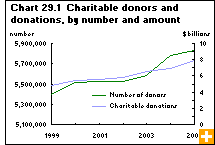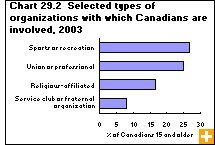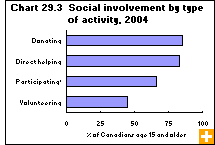Common menu bar links
Society and community
Archived Content
Information identified as archived is provided for reference, research or recordkeeping purposes. It is not subject to the Government of Canada Web Standards and has not been altered or updated since it was archived. Please contact us to request a format other than those available.
Social, economic and demographic changes are reshaping Canadian society. People are seeing less of their families and friends on workdays, and spending much more time alone.
Yet Canadians can generally be described as involved citizens, generous with their money and their time. Most also like to stay well informed. They consume a considerable amount of news and current affairs information. Similarly, they tend to be more involved in political activities other than voting, such as attending public meetings, searching for information on political issues, volunteering for a political party, or expressing their point of view by contacting a newspaper or politician, by signing a petition or by participating in a march or demonstration.
Charitable donations
Canadians continued in 2005 to give generously to registered charities and non-profit organizations. Over 5.8 million Canadian taxfilers donated a record $7.9 billion to charities that provide official tax receipts—almost 1% more donors, and 13.8% more in total donations compared with 2004.
Donations rose in all provinces and territories. The strongest increases were 21.1% in Alberta, 18.5% in Nova Scotia and 17.7% in Manitoba. The number of donors also grew everywhere except Saskatchewan and Newfoundland and Labrador. In those two provinces, the number of donors slipped, but not the dollars donated.
At the national level, the median total income of donors in 2005 was $45,400, up 3.9% from 2004. The median donation rose 4.3% from $230 to $240.
Nunavut’s donors had the highest median income in 2005, at $77,100, as well as the highest median donation, at $400. But Alberta reported the largest growth in donors’ median income, 6.1%, and a 3.6% rise in median donation, from $280 to $290.
The average age of donors across the country in 2005 was 52 years, unchanged from 2004. Donors in Nova Scotia were the oldest, on average, at 55 years of age; donors in Nunavut and the Northwest Territories had the youngest average age of charitable donors, at 44 years.
Volunteering and civic participation
About 34% of Canadians said they did volunteer work in 2003. Rural residents are more likely than urban residents to do volunteering—even when factors like age, gender, household income, level of education, place of birth, province of residence and marital status are taken into account.
Differences between rural and urban residents narrow when it comes to involvement or membership in different types of organizations, such as professional associations, sports or recreation organizations, religious groups, or service clubs and fraternal organizations. Yet, in 2003, rural residents were more likely than urban dwellers to be involved in service clubs and fraternal organizations. Citizen involvement in the political process, such as attendance at public meetings on local affairs, is more frequent in rural areas and small towns than in large cities. In 2003, the larger the place, the lower the proportion of individuals who said that they attended a public meeting.
Social networks in urban and rural Canada
Many people believe that residents of large urban areas are more likely to be socially isolated or to see friends less often than those living in rural communities. That is not the case in Canada.
Granted, the social networks of Canada’s urban dwellers do include a smaller slice of family and neighbours. However, their networks also include a larger slice of friends and acquaintances. Rural residents, by contrast, have a larger share of neighbours and family members in their close social networks, but the share of friends is smaller.
Isolation from family
Rural residents are no more or less likely than urban dwellers to be isolated from family. Among the Canadian-born population in 2003, an equal proportion of rural residents and urban dwellers had not seen their relatives in a month. However, the proportion of rural residents who saw their relatives a few times a week or every day was higher.
Canadians living in rural areas are just as likely as Canadians living in the country’s largest census metropolitan areas (CMAs) to say they do not have any close friends. Also, rural residents are very similar to urban dwellers when it comes to the kind of help they give their friends, neighbours and relatives.
People living in Canada’s large CMAs are perhaps less likely to help with transportation or domestic chores, because this kind of help is less important for people in their social networks. They are also slightly less likely than rural residents to help others in their circle with child care. However, in 2003, urban dwellers were just as likely as residents of any other area to provide emotional support, teach, coach or give practical advice, or to help a person in some other way.





